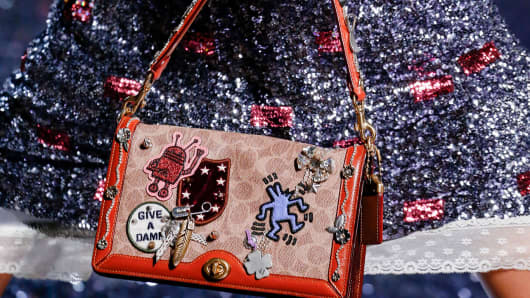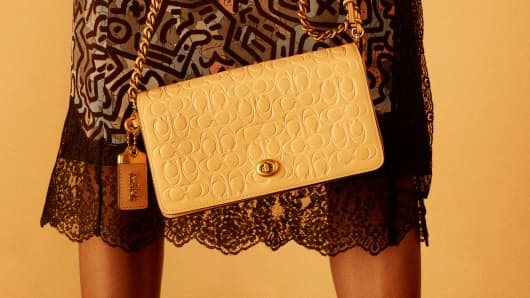- The Coach brand is bringing back logo designs into its product mix.
- The move comes as more fashion brands have noted the growing appeal of 90s styles.
- Ralph Lauren, Perry Ellis, Guess and Abercrombie & Fitch all noted the logo trend on recent earnings calls.
Courtney Reagan | Courtsy by CNBC

Coach Signature handbag
When it comes to fashion, flashy logos have been out of vogue for a while. But a number of premium retailers say logos are back.
Coach Brand President & CEO Josh Schulman told investors on the company's second-quarter conference call that the company is seeing "a global movement in luxury brands toward a higher penetration of logo product."
The recognizable Coach "C" print has not been a part of the handbag maker's main assortment for several years as it has been undergoing a brand transformation, but that will change soon.
Tapestry, the parent company of Coach, Kate Spade and Stuart Weitzman, is reintroducing logo into its retail store and website assortment as part of the new inventory designed by Coach creative director Stuart Vevers. The collection will hit stores and the website on March 1.
Schulman says the early response from the editorial and wholesale community, including Harper's Bazaar the Neiman Marcus catalog team, has been "terrific."
Coach has already begun to increase the logo product available in its outlet business.
Piper Jaffray analyst Erinn Murphy estimates in the most recent holiday quarter, Coach outlet stores dedicated about 20 percent of the floor space to logo product.
The handbag maker isn't the only company bringing back logos.
Murphy says she's started to see "a renaissance of logo," largely led by luxury players like LVMH, Gucci and Balenciaga, but also including what she calls premium players like Calvin Klein, Tommy Hilfiger (both owned by PVH) and Donna Karan (part of G-III Apparel Group).

Coach Signature handbag
Millennials in particular are gravitating towards logos, after years of preferring, at least outwardly, more incognito fashion labeling.
"Logos are part of a trend back to the 1990s broadly, in fashion," explains Murphy. "Brands are going back to the archives."
Ralph Lauren, Perry Ellis, Guess and Abercrombie & Fitch all acknowledged the logo trend on their most recent earnings calls.
"Polo Bear sweaters and novelty items embellished with our iconic symbols like our crest logo and downhill ski racer graphic were among our bestsellers for the [holiday] season," Ralph Lauren CEO Patrice Louvet told investors last week.
Perry Ellis' Original Penguin "logo apparel is right in fashion with today's 1990s trend favoring logoed apparel," according to CEO Oscar Feldenkreis in December.
In November, Guess CEO Victor Herrero said, "We are seeing a lot of logo-driven fashion," while Abercrombie & Fitch CEO Fran Horowitz said men's apparel improvement was driven in part by logo shorts and fleece.
Coach has not said exactly how many items will be part of the new Signature logo collection.
Schulman did say Coach is going to take a very "measured" and "disciplined approach" as it reintroduces the signature logo product, "building on the organic demand that is bubbling."
Murphy says that much of Coach's most significant growth era in the mid-2000s was heavily reliant on the logo product, potentially 60 to 70 percent of floor space, and she doesn't expect that level of resurgence.
What's more encouraging to Murphy is Tapestry's acknowledgement that the logo product in the outlet has begun to bring in a new shopper.
Speaking of 1990s trends, Tapestry CEO Victor Luis says North American mall shoppers are back.
On the earnings call following the release of Tapestry's better-than-expected quarterly profit and sales, Luis told investors "our retail business was driven by innovation and improved domestic mall traffic for the first time in several years."
David Simon, CEO of mall-operator Simon Property, said shopper traffic at his malls in the holiday quarter was "all generally positive and up."
Simon, known for his rosier outlook when it comes to the state of physical shopping and malls, added that from his viewpoint "traffic and sales are painting a more robust picture than the narrative out there is suggesting."

0 comments:
Post a Comment